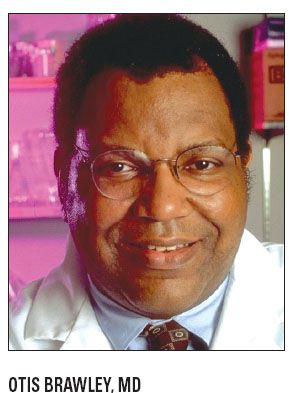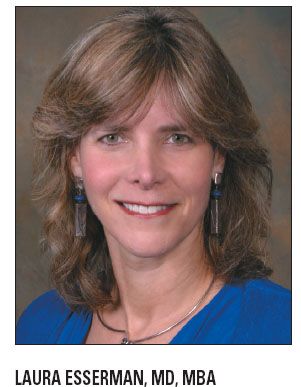JAMA article reignites debate over screening
The incidence of later-stage breast cancer has not kept pace with a substantial increase in diagnosed breast cancers, an increase achieved largely by the use of better imaging equipment and a nearly 70% screening rate among women 40 years and older. This fact, underscored in a special communication in the Journal of the American Medical Association, pokes holes in the widely held public belief that early diagnosis will prevent the majority of breast cancer deaths.
The incidence of later-stage breast cancer has not kept pace with a substantial increase in diagnosed breast cancers, an increase achieved largely by the use of better imaging equipment and a nearly 70% screening rate among women 40 years and older. This fact, underscored in a special communication in the Journal of the American Medical Association, pokes holes in the widely held public belief that early diagnosis will prevent the majority of breast cancer deaths.

The reason is that all breast cancers do not pose the same threat. Not only does this realization temper the hope that breast cancer can be defeated through the use of current screening programs, but it also raises the very real chance that these efforts are actually harming patients, wrote Laura Esserman, MD, MBA, and colleagues. Dr. Esserman is the director of the Carol Franc Buck Breast Care Center at the University of California, San Francisco, and co-leader of the breast oncology program at the UCSF Helen Diller Family Comprehensive Cancer Center.
“Without the ability to distinguish cancers that pose minimal risk from those posing substantial risk and with highly sensitive screening tests, there is an increased risk that the population will be over-treated,” Dr. Esserman and coauthors wrote (JAMA 302:1685-1692, 2009).
An imperfect but beneficial test
When the JAMA commentary appeared, a subsequent article in the New York Times reported that on the basis of comments made by Otis Brawley, MD, American Cancer Society chief medical officer, the ACS was questioning its current recommendations for breast cancer screening because of concerns about overtreatment. The ACS fired back that Dr. Brawley’s comments to the newspaper reporter were misinterpreted and stressed that its policy was unchanged (New York Times, “Cancer Group Has Concerns on Screenings,” October 21, 2009).
In a prepared statement, Dr. Brawley said the ACS stands by its recommendation that women 40 years and older should receive annual mammography screening, and women at high risk should talk with their doctors about when screening should begin based on their family history.
“This test is beneficial in that it saves lives,” he said in the statement. “But it is not perfect. It can miss cancers that need treatment and, in some cases, find disease that does not need treatment” (American Cancer Society, October 21, 2009, www.cancer.org).
Dr. Brawley had been saying this for years about mammography and also about prostate-specific antigen (PSA) testing for prostate cancer (see “Introduction of PSA testing leads to dramatic rise in cancer incidence,” page 35, September 2009). Dr. Esserman and colleagues argued that the benefit from breast and prostate cancer screening falls far short of public expectations, because these technologies are adept at finding cancers that may not be life-threatening and not so adept at uncovering the more dangerous ones.

This realization, after decades of hearing that early detection will dramatically reduce cancer mortality, is humbling, said Andrew Seidman, MD. But Dr. Seidman, an attending physician at Memorial Sloan-Kettering Cancer Center in New York, said it should not be seen as a reason to abandon screening.
“Therein lies the inherent danger of misinterpreting the shortcomings of current screening programs for breast and prostate cancer,” Dr. Seidman told Oncology News International.
Dr. Esserman agreed. “The message is to use screening more wisely and to do a better job with the information that we generate from screening,” she told Oncology News International.
Judd W. Moul, MD, professor of surgery and chief of the division of urologic surgery at Duke University Medical Center in Durham, N.C., echoed those sentiments for PSA screening. “As a clinician, one of the things that I don’t want to see happen is for us to go back to what I call the pre-PSA era. I don’t want us to stick our head in the sand,” Dr. Moul said.
In the 1980s, before PSA testing, between 20% and 25% of men who received a diagnosis of prostate cancer had bone metastases, according to Dr. Moul. This was “pretty much a death sentence,” he said. Back then, more than 40,000 men died of the disease annually. This number has since been cut in half.
But there is a caveat to Dr. Moul’s support of PSA testing. “I also recognize that we have a lot of men diagnosed with very small prostate cancers that may never harm them,” he said. “The issue is what to do with these cancers. We have to recognize that not all of these patients need to be treated.”
Dr. Seidman and Dr. Moul agreed that the JAMA article should be a call to the scientific community to do the research needed to make screening methods better. Driving the need for this research is the realization that breast and prostate cancers are heterogeneous and that current screening tests for these diseases are not as good at finding the aggressive types that may present less often. In breast cancer, these are the ones that develop in between mammograms, have rapid doubling times, and have a much higher proliferative rate.

“Those cancers are more likely to lead to mortality than the ones found as the result of a few scattered microcalcifications seen on the most recent mammogram,” Dr. Seidman said.
The observation by Dr. Esserman-that mammography excels at finding slowly growing cancers-should motivate the redoubling of efforts to improve on or supplement mammography screening, he said.
The widely held faith in the current screening method has been an obstacle to doing this work. A public recognition of the imperfections of PSA and mammography screening may provide the foundation on which a better understanding of cancer can be built.
Revamping a view of cancer
Oncologists recognize that atypical hyperplasia, ductal carcinoma in situ, and lobular carcinoma in situ present lesser risk than some other types of cancers. Their treatment, therefore, tends to be less aggressive. Future refinements will look at cancer in an even more sophisticated way.
“In the future we will be able to assess the critical genetic switches that are occurring at different levels of carcinogenesis,” Dr. Seidman said. “It is indeed conceivable that in our lifetimes we will have such molecular tools to be able to sample breast tissue and, based on genomic information, we will be able to predict who will develop a cancer and who will not.”
To get to that point, scientists must dispense with the current concept of cancer, one dating back to the 1850s, when German pathologists defined cancer seen under a light microscope in tissue taken at autopsy, Dr. Brawley told Oncology News International.v “We have developed all these new ways of imaging and new ways of screening and new ways of treating many cancers, but we have not changed our definition or even questioned our definition of cancer,” he said.

Cancer care specialists need to revamp their view of cancer to include a biomolecular understanding of the mechanisms that underlie cancer. From this may come specific tests to differentiate among less and more dangerous forms of cancer.
“In some respects we are already there,” Dr. Seidman said.
“Based on BRCA mutation status, we know that for familial breast cancer, women who harbor deleterious mutations of BRCA1 can be at extraordinarily high risk for breast cancer over their lifetimes. That kind of information has already motivated enhanced screening efforts with MRI and prevention strategies, such as the use of tamoxifen and even drastic interventions such as prophylactic mastectomy.”
Betting on biomarkers
A comprehensive understanding of cancer will require an appreciation for the biomolecular triggers that cause metastasis. “We need predictive markers so that we can have molecular level assessments of breast and prostate cancer,” Dr. Brawley said. “We must be able to say, ‘Mr. Jones, you have prostate cancer but we only need to watch it because it is probably never going to bother you,’ while at the same time saying ‘Mr. Smith, you have prostate cancer and we need to treat you or else you’re going to be in trouble in three or four years.’”
One example of cutting-edge biomarker development is a test that GE Global Research and Eli Lilly are working on (see Related Reading below). Ultimately, the technology may allow the identification of the stem cells within tumors that are believed to control the cancer. This raises the prospect of developing new and highly targeted therapies for the treatment of cancer patients.
This kind of progressive development and application of diagnostic tests makes sense, said Daniel F. Hayes, MD, clinical director of the breast oncology program at the University of Michigan Comprehensive Cancer Center in Ann Arbor.
“We can’t just introduce these things into practice. We have to really apply clinical and scientific research rigor. A bad biomarker [test] can be as bad as a bad therapeutic,” Dr. Hayes said.
Dr. Hayes said he would like to see greater value placed on diagnostic tests, a value on par with that given to therapeutics. This appreciation means diagnostic tests would have to be held to a standard similar to the one applied to therapeutic drugs in terms of clinical testing and acceptance, but developers would then be compensated better as well.
“I would like to have more regulation [of diagnostics] and more payback [to their developers],” he said.
In the meantime, the public is left with imperfect screening solutions based on less than ideal technologies. Consequently, physicians must exercise good judgment about who should be screened.
“The 80-year-old woman living independently should still get screening, because finding something will be of value to her but not the 75-year-old living in a nursing home who is unable to put one and one together to make two,” Dr. Hayes said.
Dr. Esserman suggested that population screening should not be conducted in women over 79 where there is no data to show benefit, especially when the cancers are slow growing and are less likely to be life threatening.
The limitations of current screening methods should not dissuade the vast majority of women and men from being screened for breast and prostate cancers, according to Dr. Brawley, who believes a more realistic view of screening, particularly for breast cancer, can increase the number of people participating.
“The proportion of women getting screening mammography went down in the last two years because it is getting harder to find radiologists who are willing to do it,” he said. “Radiologists are afraid of lawsuits; they are afraid that if a woman gets a mammogram and it is called normal and she develops breast cancer a year or year and a half later, juries will conclude that it must be the doctor’s fault because it can’t be the fault of mammography”.
That may change, if Dr. Brawley and others like him succeed in giving the public a realistic view of mammography. In this way, their efforts may increase access to mammography. They may also spur the kind of research needed to make this and other types of cancer screening more effective.
Visually characterizing cancer: There’s a map for that

GE Global Research and Eli Lilly have collaborated on a tissue-based biomarker technology that can map more than 25 proteins present in tumors, providing a visual map of biomarkers that can help characterize the cancer. The new technology has been tested successfully on colon and prostate cancer tissue samples and may be applicable to many other cancers.
The prototype system stains, washes, and re-stains tissue samples for study under a digital optical microscope. The system combines image analysis of cancerous cells and structures with visualization tools to provide a color map of protein concentrations within the sample. This map may allow physicians to distinguish different types of cancer. It may also indicate patient response to therapy.
“We can imagine a scenario in which this technology can be used to determine the prognosis of the patient, as well as what the optimal therapy would be,” said John Burczak, PhD, GE chief scientist for molecular imaging.
GE and Lilly plan to apply the technology next summer in research labs conducting preclinical studies at Lilly. Later applications will be done in clinical trials to test therapeutic drugs. GE plans eventually to evolve the technology as a test for use on tissue biopsies to characterize suspicious lesions found on medical imaging exams.
Continuing tests will expand initial results with the technology on colon and prostate cancers to include those of the breast, ovaries, lung, and possibly gastric system, just as the technology migrates from research labs to clinical tests and routine use.
How Supportive Care Methods Can Improve Oncology Outcomes
Experts discussed supportive care and why it should be integrated into standard oncology care.